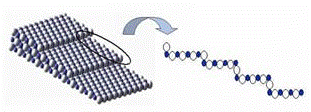Chemistry, Department of: Faculty Series

Marjorie A. Langell Publications
Document Type
Article
Date of this Version
2-1-2001
Abstract
Nickelocene adsorption and decomposition on the Ag(100) surface were studied with temperature programmed desorption and high resolution electron energy loss spectroscopy. At monolayer coverages on the relatively inert Ag(100) surface at 175 K, nickelocene physisorbs molecularly, with its molecular axis perpendicular to the surface plane. Nickelocene begins decomposing to adsorbed cyclopentadienyl and nickel at 225 K. Molecular desorption is only observed from multilayer material, at 210 K, or from the first monolayer if adjacent surface sites for decomposition are not available. The cyclopentadienyl decomposes through disproportionation to cyclopentadiene, which desorbs, and adsorbed nickel and carbon fragments on the Ag(100) surface with a maximum at 525 K.


Comments
Published in Surface Science 472:3 (February 1, 2001), pp. 155-171; doi:10.1016/S0039-6028(00)00939-0 Copyright © 2001 Elsevier Science B.V. Used by permission. http://www.sciencedirect.com/science/journal/00396028